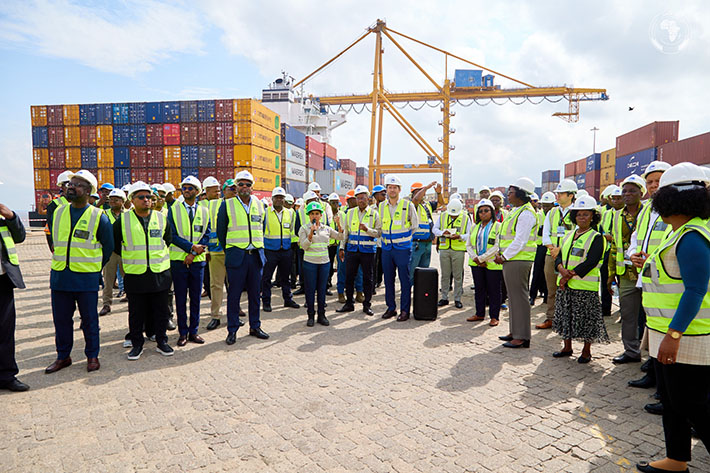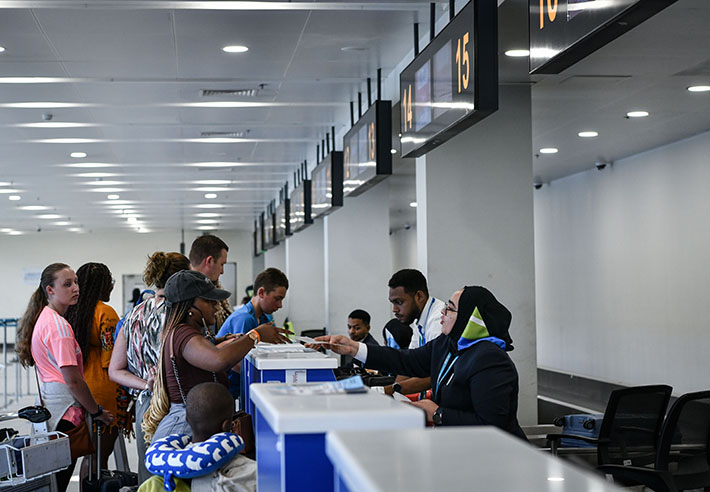|
||||||||||
| Home Top News Economy/Tech Culture/Sports China in Foreign Eyes Green Development Videos Intangible Cultural Heritages |
|
||||||||||
| Home Top News Economy/Tech Culture/Sports China in Foreign Eyes Green Development Videos Intangible Cultural Heritages |
| ChinAfrica |
| A Renaissance for Africa |
| AU’s Agenda 2063 sets out the vision and course of action for integration and sustainable development |
| By Zhang Chun | VOL. 17 June 2025 ·2025-06-04 |

An event is held to mark Mozambique’s f irst shipment of goods under the AfCFTA framework in Beira, Mozambique, on 27 April (AFCFTA SECRETARIAT)
Launched by the African Union (AU), the Agenda 2063 is a 50-year blueprint for Africa’s inclusive and sustainable socio-economic development. In terms of timeline, the plan is divided into five 10-Year Implementation Plans. The first plan ran from 2014 to 2023, and the current phase spans from 2024 to 2033. Thematically, it aims to achieve Seven Aspirations, each with specific goals designed to drive the continent towards its grand vision for 2063.
At the heart of this vision is the Aspiration 2: “An integrated continent, politically united and based on the ideals of Pan-Africanism and the vision of Africa’s Renaissance.” This ambitious goal is translated into tangible action at three primary levels.
Firstly, it advocates for a united Africa, driving continental unity and integration to promote sustainable growth, robust trade, free exchange of goods and services, and unhindered movement of people and capital, with the African Continental Free Trade Area (AfCFTA) serving as a cornerstone.
Secondly, it envisions world-class infrastructure spanning the continent, calling for improved connectivity through ambitious initiatives to link Africa by rail, road, sea, and air, while also developing necessary regional energy pools and ICT networks.
Thirdly, it calls for complete decolonisation, ensuring an end to all colonial vestiges and the liberation of occupied territories, with specific commitments to resolve the status of the Chagos Archipelago and the Comorian island of Mayotte, and to affirm self-determination for Western Sahara.
Initial achievements
Since the launch of Agenda 2063, tangible progress has brought these ideals closer to reality. On the decolonisation front, in 2024, Mauritius and the UK reportedly reached an “agreement in principle” on the return of the Chagos Archipelago, a significant development that now awaits final confirmation.
Economically, the AfCFTA, officially launched on 1 January 2021, has shown early promise despite pandemic-induced disruptions. According to International Monetary Fund data, Africa’s total external trade grew by an impressive 81.39 percent between 2020 and 2022, rising from $780 billion to $1.4 trillion. Intra-African trade also recorded a substantial rise, jumping from $124.3 billion to $209.1 billion. The figures demonstrate the initial impact of the free trade area.
Institutionally, the AU initiated reforms based on the 2017 Kagame Report. Initial institutional restructuring has been completed, and the African Peace and Security Architecture has been strengthened. The appointment of Kenyan President William Ruto in February 2024 to succeed Rwandan President Paul Kagame as the new champion for AU institutional reforms marks the start of a new phase in this ongoing endeavour.
Infrastructure has also seen substantial development, with Africa’s overall infrastructure stock nearly doubling between 2005 and 2022. While transport infrastructure growth was more modest, energy infrastructure expanded by 60 percent, and ICT infrastructure experienced a remarkable near 46-fold increase.
Delving deeper into the implementation, the specific goals under Agenda 2063’s Aspiration 2 were initially described as the “Three Connectivities.” Policy Coordination (Goal 8), aimed at establishing a unified governance framework and steering Africa towards a confederation or federation, saw a striking 98 percent completion rate in the AU’s 2022 progress report, a significant rise from 12 percent in 2019, with the AfCFTA’s launch being a landmark achievement. Financial Integration (Goal 9), focused on establishing continental financial institutions like an African Central Bank and a Pan-African Stock Exchange, had a reported 92 percent completion rate in the 2019 assessment, though the 2022 report omitted specific data for this item due to methodological changes. Infrastructure Connectivity (Goal 10), dedicated to building world-class networks including high-speed rail, highways, and the Single African Air Transport Market (SAATM), showed a 70-percent completion rate in 2022, a substantial improvement from 29 percent in 2019, with particularly rapid development in air transport, mobile communications, and the Internet penetration.

Passengers check in at the Chinese-built Terminal 3 of Abeid Amani Karume International Airport in Zanzibar, Tanzania, on 10 December 2024 (XINHUA)
Integration challenges
However, the overall journey towards Agenda 2063’s full realisation has been slower than anticipated, prompting a more cautious and focused approach in the Second 10-Year Implementation Plan. While the core objective - an Africa more integrated and connected - remains key, its pursuit is being refined along two strategic directions. The first involves strengthening continental implementation frameworks and driving national-level adoption of Agenda 2063 agreements, with a keen focus on operationalising the free movement of persons, the African Monetary Union, and the SAATM. The second entails enhancing connectivity levels through more concrete targets, such as achieving at least 80 percent completion of planned road networks and 50 percent of planned railway networks, ensuring 80 percent of Africa’s population has access to the Internet speeds of 6 mb/s or higher, and establishing a unified African digital market.
The current 10-year plan has significantly restructured the specific goals under the original Aspiration 2. Goal 8 (Policy Coordination), while still emphasising continental implementation, now appears to shift its focus more towards infrastructure. Goal 9 (Financial Integration) has been absorbed into the first goal related to economic growth. Meanwhile, Goal 10 (Infrastructure Connectivity) has been comprehensively strengthened, now featuring three flagship projects: the African Passport and Free Movement of People, the SAATM, and the African Integrated High-Speed Railway Network. This shift from the “Three Connectivities” of the first decade to a stronger emphasis on “Infrastructure Connectivity” in the second suggests a strategic recalibration, prioritising tangible linkages as a means of advancing political unity objectives amid real-world pressures.
This strategic pivot and the broader implementation hurdles reflect a complex interplay of internal and external pressures. Internally, the political impetus driving Pan-Africanism has evolved - from revolutionary vanguards to regional and now influential middle-tier powers. Kenya’s succession of Rwanda in spearheading AU reforms means their sustained momentum will be closely watched, potentially testing the dynamism of political integration.
Fiscal constraints also loom large, with multiple crises such as the pandemic, climate change, and debt issues placing immense pressure on domestic resource mobilisation and international development funding. While events like the 2024 Beijing Summit of the Forum on China-Africa Cooperation offer hope for new cooperation and support, the overall tight fiscal situation is unlikely to change fundamentally in the short term.
Furthermore, the security situation, marked by frequent terrorist incidents and deteriorating public order in some regions, undermines investor confidence and hinders project implementation.
Externally, shifts in the international environment, including an accelerating transformation of the global system and protectionist policies adopted by some Western major powers, threaten to curtail African nations’ strategic autonomy and room for policy experimentation. Global economic uncertainty, characterised by sluggish recovery and geopolitical conflicts, also negatively impacts Africa’s development and integration.
Against this challenging backdrop, principles such as equality, mutual respect, and win-win cooperation, as embodied in China-Africa cooperation, offer African nations a relatively stable guiding framework for external cooperation. These principles help African countries to maintain strategic flexibility and preserve policy space within a complex international setting, thereby providing valuable room to manoeuvre in advancing Pan-African ideals and the practical pathways of African integration.
The author is Professor of Institute of International Relations, Yunnan University
| About Us | Contact Us | Advertise with Us | Subscribe |
| Copyright Beijing Review All rights reserved 京ICP备08005356号-5 京公网安备110102005860号 |